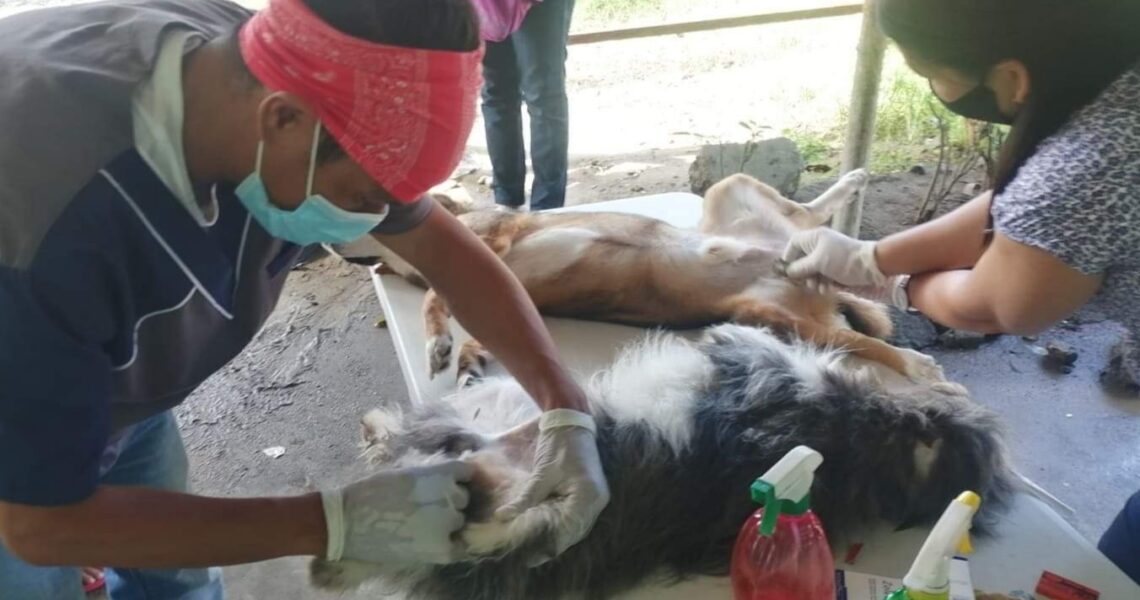Acne – Canine
Canine acne is also called muzzle folliculitis and furunculosis. A chronic inflammatory disorder of the chin and lips of young animals.
Characterized by folliculitis and furunculosis; rarely comedogenic as seen in “true acneiform” lesions of human beings.
Recognized almost exclusively in short-coated breeds.
Genetic predisposition and local trauma may play a more important role than hormonal effects.
SIGNS
Ventral chin and lip margins may be minimal to markedly swollen with numerous erythematous papules and pustules.
Initial lesions are sterile; bacteria may not be isolated and lesions may not respond to antibiotics.
Advanced stages—lesions may be exudative, indicating secondary deep bacterial folliculitis-furunculosis.
Lesions may be painful on palpation; most are non-painful and non-pruritic.
Chronic resolved lesions may be scarred and lichenified.
CAUSES & RISK FACTORS
Some short-coated breeds appear to be genetically predisposed to follicular hyperkeratosis and secondary bacterial infection.
DIAGNOSIS
DIFFERENTIAL DIAGNOSIS
Dermatophytosis
Demodicosis
Foreign body
Contact dermatitis
DIAGNOSTIC PROCEDURES
Bacterial culture and sensitivity testing—in patients with suppurative folliculitis and furunculosis that are non-responsive to initial antibiotic selection.
Biopsy—histologic confirmation for cases in which diagnosis is in question.
Skin scrape—demodicosis.
Dermatophyte culture—dermatophytosis.
PATHOLOGIC FINDINGS
Clinical signs and histopathologic findings are diagnostic.
Initial lesions—hairless follicular papules; characterized histopathologically by marked follicular keratosis, plugging, dilatation, and perifolliculitis.
Bacteria—not present and cannot be isolated from lesions in early stages.
As the disease progresses, papules enlarge and rupture, promoting suppurative folliculitis and furunculosis.
TREATMENT
Depends on the severity and chronicity of the disease.
Reduce behavioral trauma to the chin (e.g., rubbing on the carpet, chewing bones that increase salivation).
Frequent cleaning with benzoyl peroxide shampoo or gel.
Mupirocin 2% ointment to reduce the bacterial numbers on the surface of the skin.
Instruct owners to avoid expressing the lesions, which may cause internal rupture of the papule and massive inflammation.
MEDICATIONS
DRUG(S)
Topical
Benzoyl peroxide shampoo or gel (antibacterial).
Mupirocin 2% ointment (antibacterial-staphylococcus).
Tretinoin (Retin-A)—may reduce follicular keratosis.
Corticosteroids—may be necessary to reduce inflammation; limit frequency of use to avoid local and systemic effects.
Systemic
Antibiotics appropriate for deep bacterial infection—when indicated (e.g., cephalexin, 22 mg/kg PO q8–12h for 6–8 weeks).
May need to perform bacterial culture and sensitivity test.
Isotretinoin (Accutane)—1–2 mg/kg/day.
Oral corticosteroids: tapering dosages of prednisolone (initial 0.5 mg/kg/day) to reduce significant inflammation; not for continued use.
CONTRAINDICATIONS/POSSIBLE INTERACTIONS
Benzoyl peroxide—may bleach carpets and fabrics; may be irritating.
Mupirocin ointments—greasy; may be prudent to reserve for use in multidrug-resistant cases.
Topical retinoids—may be drying and irritating.
Topical steroids—may cause adrenal suppression and thinning of skin with repeated use.
Isotretinoin—may cause keratoconjunctivitis sicca, hyperactivity, ear pruritus, erythema of mucocutaneous junctions, lethargy with vomiting, abdominal distension, anorexia with lethargy, collapse, and swollen tongue; CBC and chemistry screen abnormalities include high platelet count, hypertriglyceridemia, hypercholesterolemia, and high alanine transaminase.
FOLLOW-UP
PATIENT MONITORING
Continue antibiotics until lesions have healed.
Repeat bacterial culture/sensitivity if lesions worsen.
Discontinue topical corticosteroids when possible.
EXPECTED COURSE AND PROGNOSIS
Long-term topical treatment may be required.
Chronic scarring may be prevented by early and aggressive therapy.
MISCELLANEOUS
PREGNANCY/FERTILITY/BREEDING
Synthetic retinoids—teratogens; do not use in pregnant animals, animals intended for reproduction or intact female animals; should not be handled by women of childbearing age.

